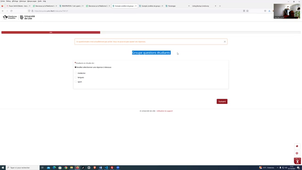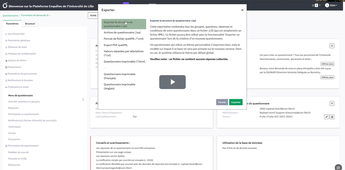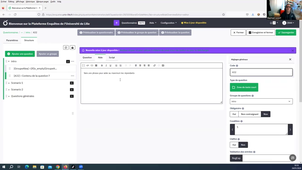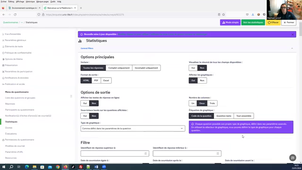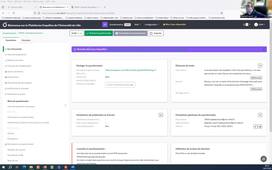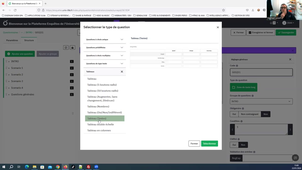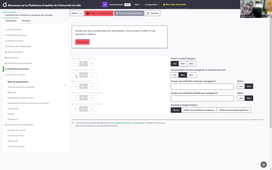Video tutorials
The videos
Technical Data Sheets
Video 1
Details of questionnaire parameters
Questionnaire parameters on the LimeSurvey Institutional Survey Platform - part 1
Optimise Your Surveys: A Complete Guide to Questionnaire Settings in LimeSurvey
LimeSurvey, as a powerful online survey creation tool, offers a multitude of customisable settings to allow you to shape and manage your questionnaires effectively. Understanding these settings can make the difference between an ordinary survey and an exceptional one. In this article, we'll explore the key questionnaire settings in LimeSurvey and how to use them to maximise the effectiveness of your surveys.
Go to Settings :
Before diving into the details, it's important to know how to access your questionnaire settings. Once you have created your questionnaire in LimeSurvey, you can access its settings by clicking on the "Questionnaire settings" tab in your survey management dashboard.
General Settings :
- Questionnaire language: Choose the language in which your questions and answers will be displayed for participants.
- Progress bar: Activate or deactivate the progress bar to inform participants about the progress of their survey.
- Navigation Options: Customise navigation options such as the ability to go back or skip to the next question.
Display settings :
-
Customised texts: Customise greetings, endings and other texts displayed to participants.
Privacy and Security Settings :
- Cookies and Sessions: Configure cookie and session options to optimise data security and confidentiality.
- Guest Access: Activate anonymous access to questionnaires to allow participants to answer without having to log in.
Participation parameters :
- Limit Responses: Define a maximum number of responses authorised for your survey.
- Close Date: Schedule the survey to close automatically at a specific date and time.
Notification parameters :
- Email Notifications: Set up notifications to be informed of new responses or other events related to your survey.
- Results Sharing: Enable results sharing with other LimeSurvey users.
Conclusion :
y understanding and controlling these settings, you can tailor your survey in LimeSurvey to meet your exact requirements. Whether you're looking to maximise privacy, customise appearance or optimise response management, LimeSurvey offers a comprehensive range of settings to help you create effective and professional surveys. Explore these options to ensure the success of your online survey projects.
Video 2
The different types of questions possible
Exploring the Infinite Possibilities : The Different Types of Questions in LimeSurvey
LimeSurvey, an online questionnaire creation tool, offers a diverse range of question types to enable users to design surveys tailored to their specific needs. Whether you're looking to collect quantitative or qualitative data, or to capture complex responses, LimeSurvey offers a variety of formats to suit all requirements. In this article, we'll explore the different question types offered by LimeSurvey, opening up a range of possibilities for rich, personalised surveys.
Multiple Choice Questions (MCQ) :
Multiple choice questions are among the most commonly used in surveys. LimeSurvey allows you to create simple multiple-choice questions with a single answer, multiple-choice questions where several answers can be selected, or scaled multiple-choice questions to assess preferences.
Likert scale questions :
Likert scale questions allow you to explore participants' opinions on a scale of predefined responses. LimeSurvey offers the flexibility to customise these scales according to the nuances of your questions.
Free text questions :
To gather qualitative information or detailed comments, free text questions are essential. LimeSurvey allows participants to express themselves freely, providing rich and diverse perspectives.
Questions Numeriques :
Numerical questions can be used to collect quantitative data. LimeSurvey offers the option of defining numerical ranges, number entry fields or requesting numerical evaluations.
Matrix questions :
Matrix questions are ideal for gathering opinions on several aspects of a subject. LimeSurvey allows you to create simple or complex matrices with specific scales for each dimension
Conditional Questions :
LimeSurvey offers conditional questions that allow the questionnaire to be dynamically adjusted according to previous answers. This offers maximum customisation and enables participants to be directed towards specific questions based on their previous answers.
Image Selection Questions :
For a more visual user experience, LimeSurvey offers image selection questions. Participants can choose from predefined images to express their preferences or opinions.
Ranking questions :
Ranking questions allow participants to order or rank items according to their preferences. LimeSurvey offers options for simple or complex ranking.
Date and Time :
To collect time-related information, LimeSurvey offers specific questions for dates and times. This can be useful for planning events, assessing trends or obtaining time-related data.
Conclusion :
The diversity of question types offered by LimeSurvey gives survey designers unrivalled creative freedom. Whether you're looking for precise quantitative responses or detailed qualitative feedback, LimeSurvey provides the tools to design bespoke questionnaires. Explore these options to create engaging surveys tailored to your specific objectives, enabling you to collect rich and meaningful data.
Video 3
Setting a condition on a question in a questionnaire
Optimise Your Surveys with Question Conditions in LimeSurvey
LimeSurvey, a versatile tool for creating online questionnaires, offers a powerful feature that dynamically adjusts the content of a questionnaire based on previous responses. Question conditions, also known as conditional branches, allow you to personalise the experience of participants by creating specific paths based on their responses. In this article, we'll explore how to set up question conditions in LimeSurvey to maximise the relevance of your surveys.
Step 1: Creating your questionnaire
Before you can apply conditions, make sure you have created your questionnaire in LimeSurvey by adding all the necessary questions.
Step 2: Adding Conditional Questions
-
Access the Questionnaire Editor: Log in to your LimeSurvey account and open the questionnaire you wish to modify.
-
Select the Question: Identify the question for which you want to add a condition. Click on the question in the editor to access its parameters.
-
Question parameters: In the question parameters, look for the "Add a condition" option. This option may also be called "Conditional branches" or something similar.
-
Define the Condition: Choose the answer to which the condition should be associated. For example, you could say that if the answer to the previous question is "Yes", then display the current question.
Step 3: Customise Conditional Actions
-
Define Actions: LimeSurvey offers several actions that you can associate with a condition. You can choose to show or hide a question, skip to a specific question, or even end the questionnaire..
-
Test Your Condition: Use LimeSurvey's preview tool to test your conditions. Make sure that the questionnaire behaves as expected according to the answers you have defined.
Step 4: Repeat the Process as Needed
You can add conditions to several questions in your questionnaire to create personalised routes based on participants' answers. LimeSurvey allows great flexibility in creating complex conditions to meet your specific needs.
Advantages of Question Conditions in LimeSurvey:
-
Customisation: adapt the questionnaire to suit individual responses.
-
Reduce length: Eliminate unnecessary questions to make the questionnaire more succinct.
-
Better User Experience: Offer your participants a more fluid and relevant experience.
By incorporating question conditions into your LimeSurvey surveys, you can improve the quality of the data collected and deliver a more engaging user experience. Explore this feature to maximise the relevance of your questionnaires and obtain valuable information efficiently.
Video 4
Export or analyse the results of a LimeSurvey survey
Mastering the Analysis and Export of Results with LimeSurvey
LimeSurvey, a powerful tool for creating online surveys, offers not only the ability to design complex questionnaires, but also advanced features for analysing and exporting the results obtained. In this article, we'll explore the steps involved in exporting and analysing the data collected using LimeSurvey.
Export Results:
-
Log in to LimeSurvey: Log in to your LimeSurvey account and access the survey for which you wish to export results.
-
Survey selection: Go to the "Results & participants" tab of your survey.
-
Choice of Export Format: LimeSurvey offers various export formats such as CSV, Excel, SPSS, etc. Select the format that best suits your needs.
-
Configure Export Options: Before launching the export, configure the options according to your preferences. This may include the choice of columns to export, the selection of participant groups, etc.
-
Launch export: Once the options have been configured, launch the export. LimeSurvey will generate a downloadable file containing all the data collected.
Analysing results:
-
Using Integrated Reports: LimeSurvey offers built-in reports that provide a graphical view of results. Explore these reports for a quick understanding of trends and responses.
-
Creating customised reports: For in-depth analysis, use the custom report creation tool. Choose specific questions, apply filters and generate tailor-made reports.
-
Statistical Analysis: For in-depth statistical analysis, LimeSurvey allows data to be exported to third-party software such as SPSS. Import data into your preferred statistical software for further analysis.
-
Data visualisation: Use visualisation tools such as graphs or tables to make results more accessible. LimeSurvey offers built-in functionality to create attractive visualisations.
-
Share Results: LimeSurvey makes it easy to share results with other users. Use this feature to collaborate and discuss findings.
By mastering the export and analysis of results with LimeSurvey, you can maximise the potential of this robust tool. Whether you're conducting surveys for research, market research or internal data collection, LimeSurvey offers advanced features to help you draw meaningful conclusions from your data. Explore these capabilities to turn your raw results into actionable insights and make informed decisions.
Video 5
Creating a "Text Type" question in a LimeSurvey questionnaire
Practical guide: How to create a text question with LimeSurvey
LimeSurvey, an open-source online survey software, offers exceptional flexibility for designing customised surveys. If you want to collect qualitative responses in text form, creating a text question is essential. Here's a step-by-step guide to help you add a text question to your LimeSurvey survey.
Step 1: Sign in to your LimeSurvey account
Log in to your LimeSurvey account and access the survey you wish to edit.
Step 2: Add a new question
Once in the survey editing interface, select the section or page where you want to add the text question. Click on the "Add a question" button to open the question types menu.
Step 3: Select the type of text question
In the menu, choose the "Text" or "Text box" option, depending on the terminology used by your version of LimeSurvey. This option allows participants to provide detailed answers in the form of free text.
Step 4: Configuring the question
Once you have selected the type of text question, you will be redirected to the configuration page. Give your question a title to guide participants, then define a description if necessary to clarify the context further.
Step 5: Response options (if necessary)
Although the text question does not have predefined answer options like other types of question, you can always add extra options if they are needed to frame participants' answers.
Step 6: Advanced settings
Explore the advanced settings to customise your question even further. You can define answer length restrictions, add regular expressions to validate answers, or choose to show or hide the question based on specific conditions.
Stage 7: Recording and preview
Once you have configured your text question to your preferences, don't forget to save your changes. Before publishing your survey, use the preview function to see how the question will appear to participants.
Step 8: Publish the survey
Once you are happy with your question, publish your survey to make the question accessible to participants.
With these simple steps, you can easily incorporate a text question into your LimeSurvey survey, allowing participants to share their opinions, comments or experiences in a detailed and open way. LimeSurvey offers a user-friendly platform that gives you control over the design of your surveys, allowing you to gather valuable information efficiently.
Video 6
Export *.lss structure / recover your data in a VV questionnaire file
Export *.lss structure / recover your data in a VV questionnaire file - Video 6
Export a LimeSurvey survey in LSS (LimeSurvey Survey) format, follow these steps:
- Log in to LimeSurvey: Make sure you are logged in to your LimeSurvey instance where the questionnaire you want to export is located.
- Access the list of questionnaires: Go to the section where you manage your questionnaires. Usually this is in a menu like "Questionnaires" or "Surveys".
- Select the questionnaire to export: Find the specific questionnaire you want to export in the list of available questionnaires.
- Open the export options: Look for an option that allows you to export the questionnaire. Often this is found in a drop-down menu next to the quiz name or in an administration section of the quiz itself.
- Choose the LSS format: From the available export formats, select "LSS" or "LimeSurvey Survey" from the export formats menu.
- Confirm and download the export: Follow the instructions to confirm your choice of export in LSS format. LimeSurvey will then generate a file in LSS format that you can download to your computer.
- Check the export: Once the download is complete, check that the LSS file contains all the information from your questionnaire.
- Use the LSS file if necessary: You can now use this LSS file to import the questionnaire into another instance of LimeSurvey or to save a copy of your questionnaire.
These steps should allow you to easily export your LimeSurvey questionnaire to LSS format. Make sure you have the necessary permissions to perform export operations in your LimeSurvey instance.
To export your data into a VV questionnaire file, follow these steps:
If you need to export data from LimeSurvey, here is how you can export to common formats:
- Log in to LimeSurvey: Make sure you are logged in to your LimeSurvey instance.
- Access your data: Go to the section where you can view and manage the responses or data collected for your questionnaires.
- Choose the questionnaire and data to export: Select the specific questionnaire whose data you want to export. You can often filter by date, by questionnaire, or by other relevant criteria.
- Export options: Look for an option to export data. Usually this is in a drop-down menu or in an answer admin section.
- Choose the export format: Select the format: VV questionnaire file
- Confirm and download the export: Follow the instructions to confirm your export choice. LimeSurvey will then generate a file in this format that you can download to your computer.
- Verify the export: After downloading, verify that the file contains all the data you want to export.
By following these steps, you should be able to export your LimeSurvey questionnaire data to a format suitable for re-importing this collected data later.
Video 7
Set a condition for opening a group of questions on LimeSurvey
In LimeSurvey, it is possible to condition the opening of a group of questions using the conditions
Use conditions
- Log in to LimeSurvey and go to your survey.
- Select the group of questions you want to package.
In this condition, simply type an equation (example: questioncode.NAOK == "AO001" or is different "!=" or higher " >" depending on the form of your questionnaire.
When the condition is saved, the group will only be visible to people who have clicked on a question that existed before the group and which is equivalent to your condition.
Video 8
Designing an Accessible Questionnaire in LimeSurvey
New Settings When Creating Your LimeSurvey Questionnaire
At the start of the 2025–2026 academic year, we will standardize the new questionnaire presentation template. To this end, as the questionnaire author, you are required to complete a few key settings for "field"-type questions in order to comply with accessibility standards.
- date: Predefined question type (Date)
- phone number: Predefined question type (Numeric input)
- email: Short text type
- numeric fields (e.g., phone number): Predefined question type (Numeric input)
